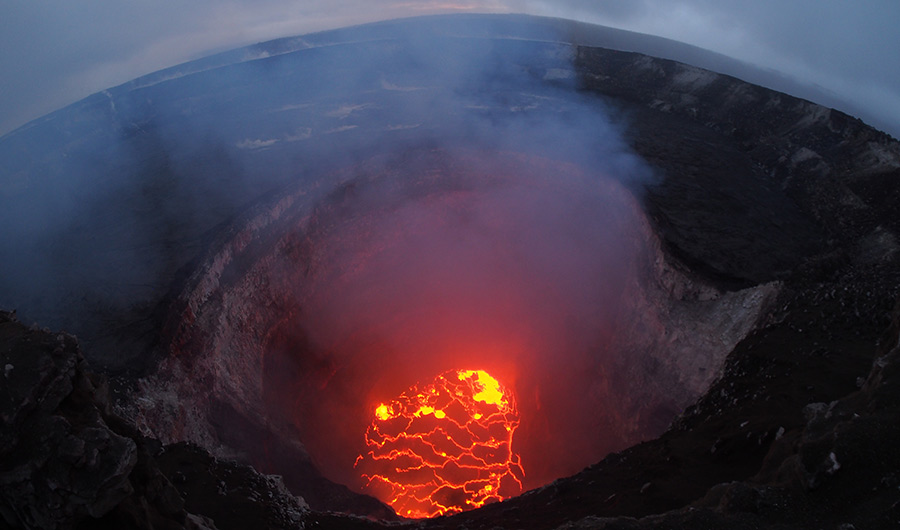Heavy Rains May Make Volcanoes Rumble
(Inside Science) -- Despite its lush tropical flora and pristine beaches, Hawaii would not have been a great place to be two years ago around this time. On April 14-15, 2018, some 49 inches of rain deluged the island of Kauai in 24 hours, setting a rainfall record for the entire United States. About two and a half weeks later, on Hawaii, the archipelago's Big Island, the volcano Kilauea awakened.
The volcano's summit crater, called Halemaumau, collapsed and its lava lake descended into the volcano's bowels. Then Kilauea's eastern flank erupted in a series of glaring red gashes in the Earth, accompanied by ash clouds and spurting lava fountains. The eruption remade the island's southeastern edge and destroyed 700 homes by the fall. Now a new study claims the record rainfall that preceded the eruption is related to the historic event — and may have even caused it to begin. Other researchers are skeptical.
The study argues that as rains lashed Hawaii, water would have surged into the island's porous bedrock, weakening the rock's existing fissures and imperfections. This would make the rock easier to break, triggering the eruption. Jamie I. Farquharson and Falk Amelung of the University of Miami suggest in a new paper that precisely this scenario led to Kilauea's historic eruption. If that's true, it suggests extreme rainfall events, which are predicted to increase in the future because of human-caused climate changes, could lead to increased volcanism in a few places on Earth. The study is published today in the journal Nature.
"If there are regions of the globe that are going to experience more extreme rainfall, it's important to understand if there are other natural phenomena that are going to be affected by that," Farquharson said.
More stories about volcanic eruptions from Inside Science
The Fiery Physics of Volcano Flows
The Quest for Magma
Scientists Detect the Sounds of Undersea Volcanoes Belching Giant Bubbles
Hawaii’s archipelago sits above a hotspot, where a plume of magma flows from Earth's deep interior independent of the motions of the tectonic plates. The plumbing systems of the islands' several volcanoes allow lava to make its way from within and reach Earth's surface, forming new rock. In Hawaiian mythology, the volcano goddess Pele lives at Kilauea, which is the youngest and most active volcano in the islands.
Kilauea's magma is stored a few miles below the surface, and several factors can combine to drive it skyward. When it rises, it needs a way out. This happens as magma stresses the rocks and exploits their weaknesses, explains Michael Manga, a geophysicist at the University of California, Berkeley who wrote a commentary on the new result for the same journal.
Pressure could build up over time, as rising molten rock creates pressure and forces Earth's crust upward to a breaking point. Or the magma chamber walls could be weakened externally, like by the tidal forces of the ocean, which result from the pull of the moon.
Farquharson and Amelung argue that rainfall is a new, previously unrecognized source of stress acting on Kilauea's internal structure. They created a model to estimate the pressure changes in the rock in the weeks leading up to the eruption, which began May 3, 2018. Their model, which also includes factors such as the density of Kilauea's rock and the vertical motion of water through the subsurface, showed a dramatic pressure increase deep within the Earth. They say the pressure change occurred while the rain was falling and percolating into the rock, and conclude that the heavy rainfall led to the eventual rock failure that enabled the eruption.
Kilauea has long been one of the world's most dangerous volcanoes. An active vent called Puu Oo on the shield volcano's East Rift Zone is one of Earth's best locations for studying eruptions. U.S. Geological Survey scientists keep a close watch on the volcano, and any odd stirrings are carefully tracked using GPS satellites and other sensors. Some of these sensors noticed changes in the days leading up to the 2018 eruption, according to USGS scientists. The agency issued two public warnings in April, based on changes in the lava lake and a slight uplift in the land. Farquharson argues these changes were slight compared to past eruptions, however. He also said the activity does not explain the eruption's genesis.
"Maybe the magma chamber was pressurizing at that time, but we don't think it was the dominant factor" in setting off the eruption, he said.
Several geophysicists were skeptical of the results and called for more hard data, even as they said rainfall is a factor worth studying.
"You can say that perhaps the rainfall had some sort of influence on the way the eruption played out; I think that would be a safer claim," said Jess Phoenix, a geophysicist in California who previously worked at the USGS Hawaiian Volcano Observatory. "But I don't think you can support that the rainfall triggered the 2018 eruption."
At Kilauea, the volcano's deep guts are bracketed by structures called intrusions, which act like walls along the volcano's East Rift Zone. These structures could prevent water from percolating through the subsurface, according to USGS scientists. Farquharson and Amelung did not address the volcano's physical structure in their analysis, they said.
Among the factors that can cause a volcano to erupt, rainwater is less influential than pressure buildup within the magma system, said Michael Poland, a USGS geophysicist who leads the Yellowstone Volcano Observatory and is a former staff scientist at the Hawaiian Volcano Observatory. He said instruments recorded pressurization of the volcano just before the heaviest rains began, and almost three weeks before the eruption.
"It's conceivable that rainfall can provide a little bit of a kick, which could cause a system that was near the edge to go fully over the edge," Poland said. "The issue here is that I don't think there is convincing evidence that this is what happened at Kilauea in 2018."
Further studies are necessary, he and others said, including comparative research at other island chains, like the Canary Islands or the Galapagos. But if they find that intense rainfall really can trigger volcanic eruptions, and rainfall is expected to increase in intensity under human-caused climate change, then a warming world may produce more volcanic eruptions.
"The implication is that when it rains really hard, a volcano may erupt, and maybe we should evacuate," Manga said. "So I think there are some conclusions where the burden of proof should be much higher."
Farquharson said he is already working on analysis of different volcano systems, looking for similar patterns that might suggest some connection to the water cycle.
If that analysis identifies certain types of volcanoes that are more likely to experience increases in stress after rainfall, "it's possible we could see an uptick in activity," he said. "But it's hard to speculate about that in our single-case study, so a big pinch of salt should accompany that."
Phoenix was less circumspect.
"I would love to blame human-caused climate change on every bad thing that ever happened, because I really want people to pay attention," she said ruefully. "But I didn't see evidence to support the claim that climate change is going to play into volcanic eruptions. There are so many factors that go into that inciting event."
Don't sound for Pele right away the next time it storms, in other words.


